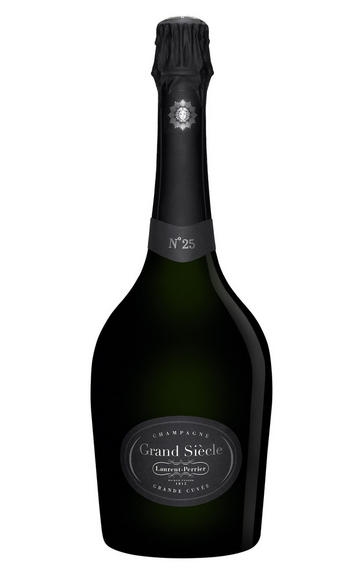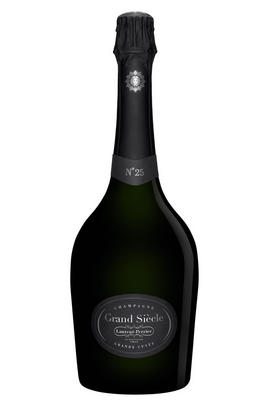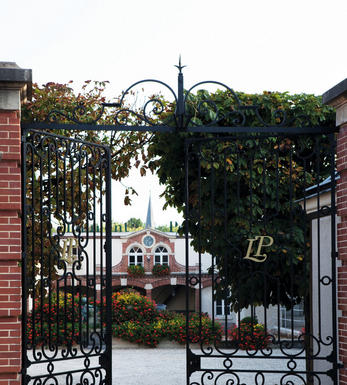
Champagne Laurent-Perrier, Grand Siècle No. 25, Brut

Critics reviews
The NV Brut Grande Cuvée Grand Siècle No. 25 is bright and gracious in feel. Orchard fruit, mint, dried flowers, lemon peel, graphite and chamomile are beautifully lifted. The No. 25 is fresh and taut but has enough fruit to be approachable now.
The blend of vintages - 2008 (60%), 2007 (20%), 2006 (20%) - is quite complementary. I liked the No. 25 more from magnum, but Champagne often shows so well in larger formats.
Drink 2022 - 2036
Antonio Galloni, Vinous.com (November 2021)
The 25th iteration of Laurent-Perrier's de luxe cuvée always a blend of different vintages in their quest to make the perfect champagne. Deep gold with the tiniest bead. Very pungently aromatic and with a texture as smooth as silk. Utterly luxurious.
Slides over the palate with an undertow of surprisingly ripe Chardonnay. I'd drink this with a sophisticated fish dish, perhaps with a rich sauce. I love the gentlest of explosions on the palate. Surely this has a lower-than-average pressure? Very long.
But it is not recommended for those who like their champagne on the austere side. This is to be launched in late 2021, but it tastes as though it was already gorgeous in 2020.
Drink 2021 - 2027
Jancis Robinson, jancisrobinson.com (February 2022)
Laurent-Perrier's imminently released NV Brut Grand Siècle #25 shows beautifully, unwinding in the glass with an incipiently complex bouquet of pear, crisp stone fruit and mandarin mingled with hints of smoke, buttered toast and dried white flowers. Medium to full-bodied, layered and textural, with a fleshy core of fruit, terrific concentration and a racy spine of acidity, it's a deep, comparatively structured wine that will evolve beautifully in the cellar.
As I've written before, this iteration is a blend of the 2008, 2007 and 2006 vintages, with 2008 lending #25 its depth and structure, 2007 contributing additional cut and 2006 additional richness. While the #25 exemplifies the seamless charm of this bottling, it's also one of the best propositions for long-term cellaring among recent renditions of Grand Siècle, and it will really reward time on the cork.
Drink 2023 - 2045
William Kelley, Wine Advocate (October 2021)
Incredible aromas of apple skin, pie crust, praline and flowers. So young in the nose. Full-bodied with super-fine tannins. It’s tight and refined yet structured and intense. Really long and beautiful. Still shy.
Wonderful finish. 12 years on its lees before disgorging. Three vintages in the blend – 2008 (65%), 2007 (25%) and 2006 (10%). 60% chardonnay and 40% pinot noir. It’s the highest percentage of chardonnay ever.
James Suckling, jamessuckling.com (February 2022)
About this WINE

Laurent Perrier
Laurent Perrier was founded by André-Michel Pierlot in 1812 in the village of Tours-sur-Marne. However, it was the Nonancourt family who made this the famous Champagne House it is today. Bernard de Nonancourt, a veteran of the Second World War, took charge of the firm aged just 28. He is credited with creating Laurent-Perrier’s house style, centred on freshness, finesse and elegance. Today, Lucie Pereyre de Nonancourt is the fourth generation of the family here.
Laurent-Perrier is unique in that its prestige cuvée, Grand Siècle, is a multi-vintage blend rather than a vintage Champagne. Each “iteration”, as they call their new releases, is produced from three vintages, carefully selected by the Cellar Master.
In 2023, Maximilien Bernardeau was appointed Cellar Master, following in the footsteps of the long-serving Michel Fauconnet.

Brut Champagne
Brut denotes a dry style of Champagne (less than 15 grams per litre). Most Champagne is non-vintage, produced from a blend from different years. The non-vintage blend is always based predominately on wines made from the current harvest, enriched with aged wines (their proportion and age varies by brand) from earlier harvests, which impart an additional level of complexity to the end wine. Champagnes from a single vintage are labelled with the year reference and with the description Millésimé.
Non-vintage Champagnes can improve with short-term ageing (typically two to three years), while vintages can develop over much longer periods (five to 30 years). The most exquisite and often top-priced expression of a house’s style is referred to as Prestige Cuvée. Famous examples include Louis Roederer's Cristal, Moët & Chandon's Dom Pérignon, and Pol Roger's Cuvée Sir Winston Churchill.
Recommended Producers : Krug, Billecart Salmon, Pol Roger, Bollinger, Salon, Gosset, Pierre Péters, Ruinart

Champagne blend
Which grapes are included in the blend, and their proportion, is one of the key factors determining the style of most Champagnes. Three grapes are used - Pinot Noir, Chardonnay and Pinot Meunier.
26% of vineyards in Champagne are planted with Chardonnay and it performs best on the Côtes des Blancs and on the chalk slopes south of Epernay. It is relatively simple to grow, although it buds early and thus is susceptible to spring frosts. It produces lighter, fresher wines than those from Burgundy and gives finesse, fruit and elegance to the final blend. It is the sole grape in Blancs de Blancs, which are some of the richest long-lived Champagnes produced.
Pinot Noir accounts for nearly 40% of the plantings in Champagne and lies at the heart of most blends - it gives Champagne its body, structure, strength and grip. It is planted across Champagne and particularly so in the southern Aube district.
The final component is Pinot Meunier and this constitutes nearly 35% of the plantings. Its durability and resistance to spring frosts make the Marne Valley, a notorious frost pocket, its natural home. It ripens well in poor years and produces a soft, fruity style of wine that is ideal for blending with the more assertive flavours of Pinot Noir. Producers allege that Pinot Meunier lacks ageing potential, but this does not deter Krug from including around 15% of it in their final blends.


Buying options
Add to wishlist
Description
A charming nose that is both pronounced but also incredibly delicate. Touches of Amalfi lemons, oranges, stewed green apples and fresh pastries entice. The palate feels surprisingly settled, given the relatively recent disgorgement and the gentle mousse, a hallmark of the cuvée. Vibrant citrus, lemon compote, apple Tarte Tatin and a steely backbone.
Delicate floral aromas give a really refreshing feel, but there is considerable potential to age. This will cellar for 4 years or 40; the choice is yours. What is clear is that Grand Siècle has been, and still is, hugely underappreciated. 60% Chardonnay and 40% Pinot Noir coming from 2008, 2007 and 2006. 12 years lees ageing.
Paul Keating, Private Account Manager, Berry Bros. & Rudd (April 2022)
wine at a glance
Delivery and quality guarantee